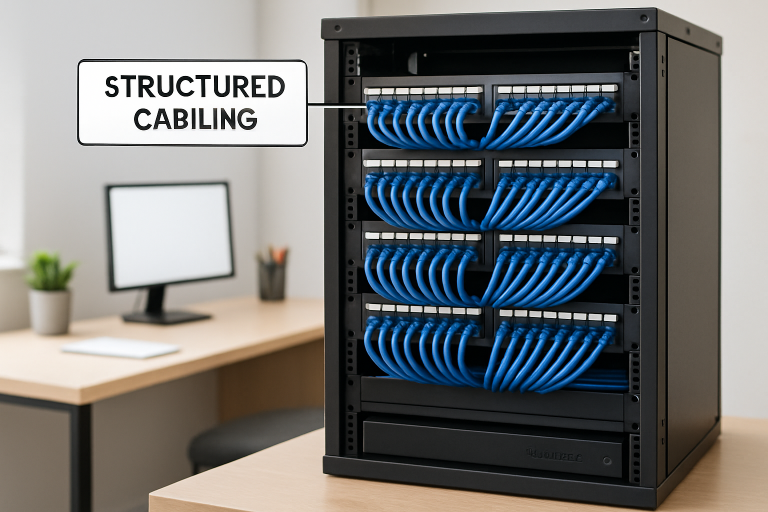Modern workspaces rely increasingly on connected technologies, automation, and the Internet of Things to boost efficiency, productivity, and employee experience. Structured cabling is at the heart of these innovations, providing a reliable, high-bandwidth network foundation that supports seamless communication between devices and cloud-based platforms. Solutions like Power over Ethernet (PoE) enable devices such as security cameras, bright lighting, and wireless access points to receive power and data through a single cable, simplifying setup and reducing costs. By implementing structured cabling, businesses can easily scale their networks, integrate advanced technologies, and maintain a flexible, future-ready infrastructure that supports current and emerging workplace demands.
Introduction to Structured Cabling
In contemporary business environments, high-speed connectivity and seamless communication are essential for productivity and innovation. Structured cabling is at the heart of this transformation, a systematic approach to organizing and managing a network’s physical infrastructure. By offering a unified and organized solution, structured cabling Los Angeles enables businesses to future-proof their workspaces and enhance operational efficiency.
More than just neat cable management, structured cabling provides the backbone for an enterprise-grade network that supports voice, data, video, and building management systems across diverse and dynamic workspaces. This comprehensive system empowers organizations to adapt to technological shifts while minimizing IT headaches and costs.
As companies increasingly invest in digital transformation and the hybrid work model, structured cabling systems support a resilient, secure, and scalable network. Well-implemented cabling avoids reliance on outdated, disorganized networks, which can jeopardize connectivity and stifle growth.
Understanding the benefits and best practices of structured cabling is crucial for any organization planning future upgrades or expansions. According to Cisco Blogs, the proper infrastructure is foundational to leveraging emergent network trends and technologies such as cloud computing, PoE, and IoT.
Benefits of Structured Cabling
Embracing a structured cabling approach yields several significant advantages that go beyond basic connectivity:
- Enhanced Performance: Organized cabling minimizes signal loss and crosstalk, ensuring fast data transfer and optimal network uptime for critical operations.
- Network Scalability: As businesses expand, structured cabling enables the straightforward integration of new devices, systems, and technologies without costly rework.
- Cost Efficiency: Although setup costs may be higher than ad-hoc solutions, the reduction in maintenance, troubleshooting, and downtime results in considerable long-term savings.
As highlighted by Cisco Blogs, strategic investments in robust cabling solutions also help prevent workplace disruptions and ensure smooth day-to-day functionality.
Integration with Emerging Technologies
Modern workplaces are evolving unprecedentedly, adopting intelligent office systems that rely on automation, real-time data, and the Internet of Things (IoT) to enhance productivity and efficiency. Structured cabling is at the core of this digital transformation—a robust, high-bandwidth infrastructure that seamlessly connects IoT sensors, automation devices, and cloud-based management systems. This foundation ensures smooth communication between technologies that monitor energy use, optimize lighting, and streamline security operations.
A prime example is Power over Ethernet (PoE), which allows networked devices such as surveillance cameras, wireless access points, and intelligent lighting systems to receive power and data through a single cable. This not only simplifies installation but also reduces energy and maintenance costs. As connected devices continue to rise, businesses equipped with structured cabling are better positioned to scale efficiently, integrate new innovations quickly, and maintain adaptable, future-ready work environments.
Designing a Structured Cabling System
Practical structured cabling projects begin with strategic planning and adherence to industry best practices:
- Assess Needs: Review current network usage and forecast future expansion, ensuring capacity for additional users, devices, and bandwidth-intensive applications.
- Select the Right Standards: Choose suitable cable types (such as Cat6 and Cat6a) and layout standards that balance speed, budget, and future readiness for the business’s unique needs.
- Plan for Redundancy: Integrate redundant cable pathways and network components to reduce potential points of failure and ensure high network availability.
- Ensure Compliance: To guarantee system safety and interoperability, follow national and regional codes and consider compliance with standards like TIA/EIA and ISO/IEC.
Common Challenges and Solutions
Deploying structured cabling presents several complexities that require thoughtful solutions:
- Space Constraints: When office or server room space is limited, utilize compact cable trays, vertical racks, and efficient routing methods to maximize storage and airflow.
- Interference Management: Keep data and power cables physically separated, and employ shielded cabling where needed to protect against electromagnetic interference that can degrade performance.
- Future-Proofing: Flexibly design the cabling system by installing additional conduits and access points to accommodate up-and-coming technologies and increasing bandwidth demands.
Case Study: Enhancing Connectivity in a Smart Office
A mid-sized company in the technology sector wanted to transform its workspace into a smart office by integrating IoT devices and automation systems. The company chose structured cabling to implement their vision, yielding:
- Superior Network Performance: With a streamlined cabling foundation, latency decreased and data transfer became more reliable, supporting everything from video conferencing to real-time analytics.
- Seamless Technology Integration: New smart devices and systems were easily incorporated without causing network disruptions or requiring physical rewiring.
- Operational Savings: Efficient cable management and reduced maintenance needs resulted in lower operating costs. The streamlined system also contributed to energy savings by enabling more innovative building management.
Conclusion
Structured cabling systems form the backbone of today’s modern workplaces, ensuring seamless communication, efficient data transfer, and the flexibility to adopt emerging technologies. These systems minimize downtime, reduce maintenance costs, and enhance overall network reliability by providing a unified and organized infrastructure. They support various digital innovations—from IoT integration and cloud computing to high-speed connectivity and intelligent office automation. Beyond immediate performance benefits, structured cabling simplifies future upgrades and expansions, allowing businesses to scale effortlessly as their needs evolve. Investing in well-planned cabling design and following industry standards boosts operational efficiency and strengthens cybersecurity, sustainability, and long-term business resilience. Ultimately, structured cabling empowers organizations to stay agile, competitive, and ready for continual technological growth in an ever-changing digital environment.
